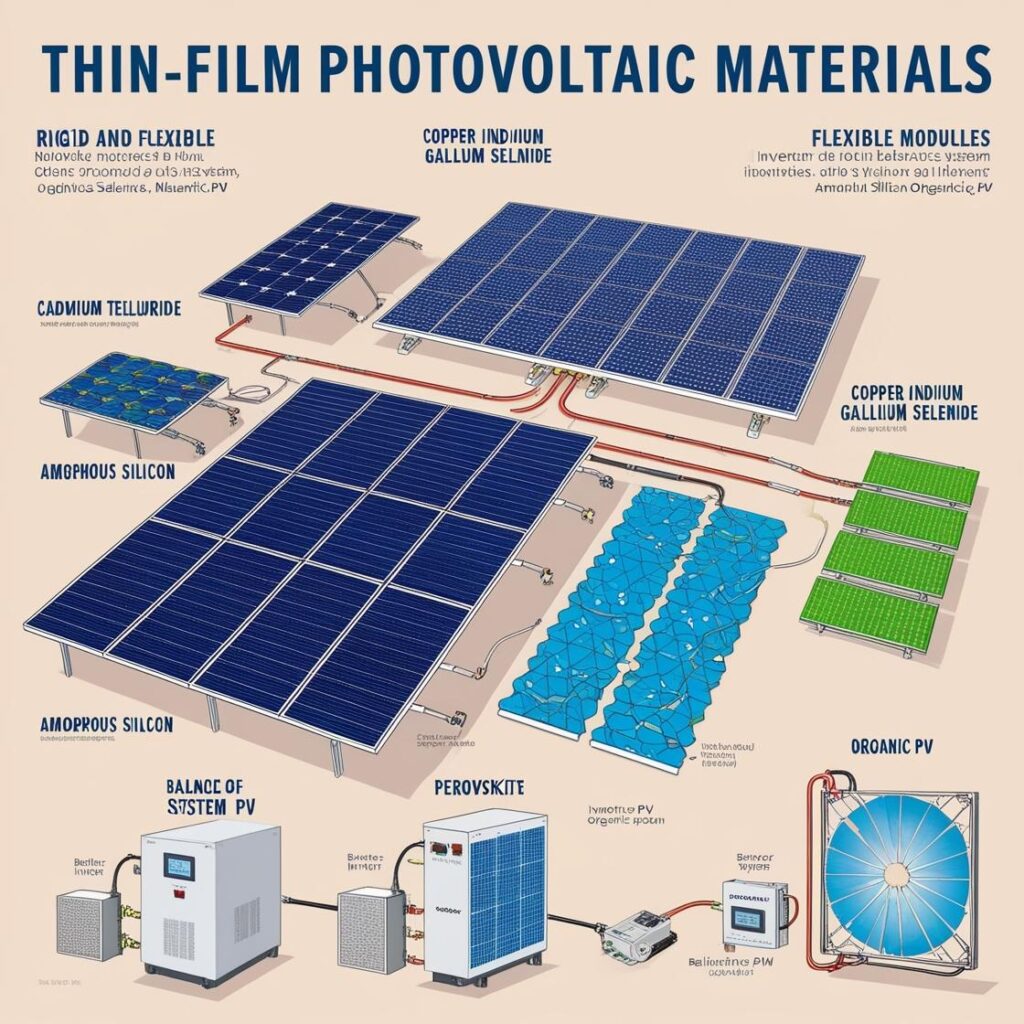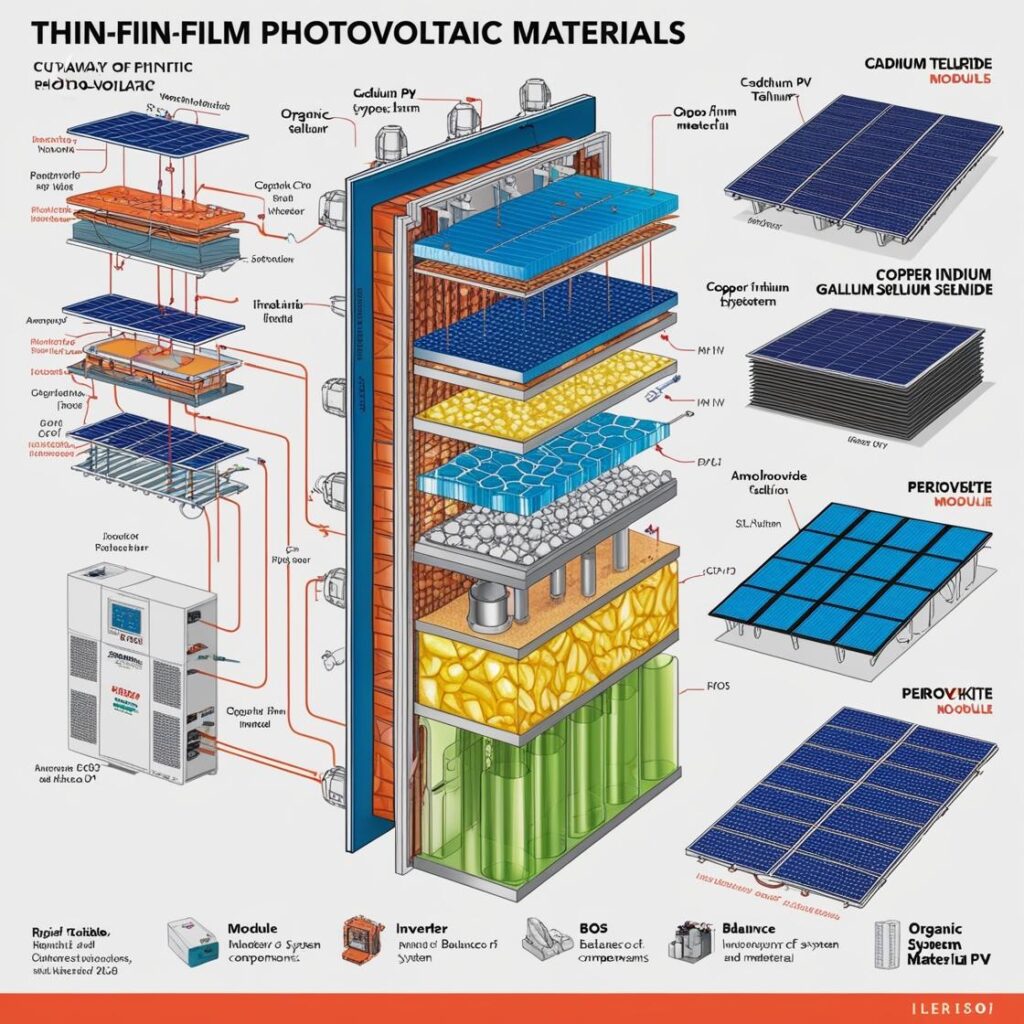As the global push for renewable energy intensifies, the thin-film photovoltaic (TFPV) industry is undergoing a radical transformation powered by artificial intelligence (AI). Once considered a niche technology within the broader solar market, TFPV is now seeing accelerated growth and innovation, thanks largely to AI-driven advances in manufacturing, materials discovery, and performance optimization.

Thin-Film Photovoltaics: A Brief Overview
Thin-film photovoltaic cells are a type of solar technology made by depositing one or more thin layers of photovoltaic material—such as cadmium telluride (CdTe), copper indium gallium selenide (CIGS), or perovskites—onto a substrate like glass, plastic, or metal. These cells offer advantages such as lightweight construction, flexibility, and lower production costs compared to traditional silicon-based solar cells.
However, challenges like lower energy conversion efficiency and complex manufacturing processes have historically limited their widespread adoption. That’s changing now, with AI emerging as a game-changer across the entire value chain.
AI in Manufacturing: From Complexity to Precision
One of the most immediate benefits of AI in the thin-film solar sector is in manufacturing process optimization. Traditional TFPV manufacturing involves numerous variables—temperature, deposition rate, layer thickness, and material composition—all of which can affect cell performance. AI models can analyze massive amounts of real-time sensor data and identify optimal manufacturing parameters more accurately and faster than human operators.
Through machine learning algorithms, manufacturers can detect anomalies during production, reduce material waste, and increase yield rates. Predictive maintenance, powered by AI, is also minimizing downtime by forecasting equipment failures before they occur. As a result, manufacturers are achieving greater consistency, quality control, and cost savings.
Download PDF Brochure @ https://www.marketsandmarkets.com/pdfdownloadNew.asp?id=31
AI-Accelerated Materials Discovery
Perhaps the most transformative impact of AI in TFPV lies in accelerating the discovery of new materials. Traditionally, finding the right material combination for solar cells was a time-consuming trial-and-error process. Now, AI is helping scientists rapidly screen and predict the performance of thousands of potential compounds using materials informatics and quantum simulations.
By modeling atomic interactions and degradation pathways, AI tools are identifying novel materials with superior light absorption, stability, and energy conversion efficiency. This has been especially impactful for emerging thin-film technologies like perovskites, which hold promise for higher efficiency at lower costs—but require careful tuning of composition and structure.
Enhancing Efficiency and Lifetime with AI
Improving the energy conversion efficiency and operational lifetime of thin-film solar cells is crucial for commercial viability. AI is enabling new frontiers here as well.
Using computer vision and deep learning, researchers and developers can analyze microscopic images of thin-film layers to detect defects and degradation patterns at an early stage. These insights help refine manufacturing methods and lead to the development of more robust devices.
Moreover, AI is being used to optimize module layout and installation design by simulating various real-world conditions—such as shading, angle of incidence, and climate data—to maximize energy output from thin-film solar panels. This leads to smarter deployment strategies that can adapt to specific environments, particularly in urban or off-grid settings.
AI-Driven Quality Assurance and Supply Chain Gains
Beyond the production line, AI is improving quality assurance and supply chain efficiency. Automated inspection systems powered by computer vision can detect minute inconsistencies in thin-film layers at high speed, reducing the need for manual checks and rework. In logistics, AI tools are forecasting demand, optimizing inventory, and streamlining delivery schedules, helping manufacturers respond more efficiently to market fluctuations.
A New Competitive Edge in Renewable Energy
The convergence of AI and TFPV technology is not only increasing performance and reducing costs—it’s also opening new markets for thin-film solutions. Flexible, lightweight thin-film panels are particularly suited for applications where conventional silicon panels fall short, such as on curved surfaces, in building-integrated photovoltaics (BIPV), or in portable power systems.
By enabling more agile and intelligent development processes, AI is giving thin-film manufacturers a crucial competitive edge in the race to deliver cleaner, cheaper, and more scalable solar solutions.
Challenges and Future Outlook
While the benefits are significant, integrating AI into TFPV manufacturing and R&D is not without its challenges. High-quality data is essential for training accurate AI models, and many companies lack the infrastructure for robust data collection and storage. There’s also a talent gap in professionals who understand both AI technologies and photovoltaic systems.
Nonetheless, the momentum is clear. As AI tools become more accessible and collaborative efforts between tech firms, research labs, and energy companies increase, the thin-film solar industry is poised for a major leap forward.
Artificial intelligence is no longer a futuristic add-on in solar innovation—it is a core enabler of the next generation of thin-film photovoltaic technologies. By enhancing everything from material discovery and manufacturing precision to product efficiency and market responsiveness, AI is helping to unlock the full potential of thin-film solar as a viable, sustainable, and scalable energy solution for the future.

Opportunities in AI-Driven Thin-Film Photovoltaics
The convergence of artificial intelligence and thin-film solar technology is opening up a wide array of new business, research, and market opportunities. As AI continues to disrupt traditional energy systems, here are the most promising areas where the TFPV industry can capitalize:
Rapid Prototyping and Commercialization
AI allows for faster design iterations and virtual testing of new thin-film materials and cell structures. This significantly shortens the time from lab discovery to market-ready products, giving manufacturers a competitive edge in a fast-evolving energy sector.
High-Efficiency, Low-Cost Solar Modules
By optimizing the manufacturing process and material compositions, AI can help increase efficiency while minimizing material usage and production defects. This translates into more affordable thin-film panels with improved power output—ideal for expanding access to solar in cost-sensitive markets.
Expansion into Flexible and Niche Applications
Thin-film photovoltaics are uniquely suited for wearables, curved surfaces, vehicles, drones, and building-integrated photovoltaics (BIPV). AI helps optimize these custom applications by tailoring designs and energy outputs to unique environmental and structural constraints.
Predictive Maintenance and Performance Analytics
AI enables real-time monitoring and predictive analytics for thin-film solar systems in the field. This can reduce maintenance costs, extend product life, and improve performance guarantees—an attractive offering for both utility-scale and distributed solar deployments.
Customized Solar Solutions for Emerging Markets
With AI’s ability to simulate performance in diverse conditions, companies can design TFPV systems optimized for specific geographies, such as high-heat or low-light environments. This makes it easier to expand into remote or underserved regions where conventional solar may underperform.
Strategic Sustainability and ESG Alignment
Companies that use AI to reduce waste, improve energy efficiency, and enhance recyclability in TFPV production can align better with Environmental, Social, and Governance (ESG) goals. This opens the door to green financing, government incentives, and investor interest in sustainable technologies.
Intellectual Property and Licensing Potential
As AI discovers novel materials and unique processing methods, companies can secure valuable intellectual property (IP). These innovations can be licensed to other manufacturers, creating additional revenue streams without the need for full-scale production.
Artificial intelligence is rapidly reshaping the thin-film photovoltaic industry, unlocking unprecedented efficiency, precision, and innovation across the entire value chain—from materials discovery and manufacturing to system performance and deployment. As the demand for sustainable energy solutions grows, AI empowers TFPV manufacturers to overcome historical limitations, reduce costs, and compete effectively in both established and emerging solar markets.
By embracing AI-driven tools and strategies, the TFPV sector is not only advancing its technological capabilities but also positioning itself as a key player in the global clean energy transition. The integration of AI is no longer optional—it is a strategic imperative for companies aiming to lead in the next generation of solar innovation.